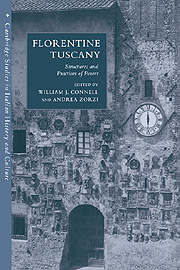Book contents
- Frontmatter
- Contents
- List of figures
- List of tables
- List of abbreviations of archival sources
- Introduction
- 1 The ‘material constitution’ of the Florentine dominion
- 2 The language of empire
- 3 Constitutional ambitions, legal realities and the Florentine state
- 4 Fiscality, politics and dominion in Florentine Tuscany at the end of the middle ages
- 5 Market structures
- 6 State-building, church reform and the politics of legitimacy in Florence, 1375–1460
- 7 The humanist citizen as provincial governor
- 8 Territorial offices and officeholders
- 9 Demography and the politics of fiscality
- 10 Florentines and the communities of the territorial state
- 11 Patronage and its role in government: the Florentine patriciate and Volterra
- 12 San Miniato al Tedesco: the evolution of the political class
- 13 The social classes of Colle Valdelsa and the formation of the dominion (fourteenth–sixteenth centuries)
- 14 Arezzo, the Medici and the Florentine regime
- 15 Rubrics and requests: statutory division and supra-communal clientage in Pistoia
- 16 A comment
- Index
- CAMBRIDGE STUDIES IN ITALIAN HISTORY AND CULTURE
5 - Market structures
Published online by Cambridge University Press: 16 September 2009
- Frontmatter
- Contents
- List of figures
- List of tables
- List of abbreviations of archival sources
- Introduction
- 1 The ‘material constitution’ of the Florentine dominion
- 2 The language of empire
- 3 Constitutional ambitions, legal realities and the Florentine state
- 4 Fiscality, politics and dominion in Florentine Tuscany at the end of the middle ages
- 5 Market structures
- 6 State-building, church reform and the politics of legitimacy in Florence, 1375–1460
- 7 The humanist citizen as provincial governor
- 8 Territorial offices and officeholders
- 9 Demography and the politics of fiscality
- 10 Florentines and the communities of the territorial state
- 11 Patronage and its role in government: the Florentine patriciate and Volterra
- 12 San Miniato al Tedesco: the evolution of the political class
- 13 The social classes of Colle Valdelsa and the formation of the dominion (fourteenth–sixteenth centuries)
- 14 Arezzo, the Medici and the Florentine regime
- 15 Rubrics and requests: statutory division and supra-communal clientage in Pistoia
- 16 A comment
- Index
- CAMBRIDGE STUDIES IN ITALIAN HISTORY AND CULTURE
Summary
In recent years, the debate on the nature and outcome of the late medieval ‘crisis’ has taken a new lease on life. According to the more recent interpretation, the demographic and political ‘crises’ acted as a catalyst for structural changes that pushed the late medieval economy onto a higher path of growth, rather than ushering in a long phase of contraction, as has long been argued by historians of a ‘neo-Malthusian’ persuasion.
This revisionist case rests on two propositions. In the first place, the consequences of the demographic slump following the Black Death are seen in a more optimistic light. On the supply side, the demographic crisis reduced population pressure on basic agricultural resources and made it possible to make more efficient use of land and labour; on the demand side, the sharp tightening of labour markets caused a redistribution of income from landlords and employers to the peasantry and urban wage earners, who spent much of their increased disposable income on cheap manufactures and on foodstuffs with higher added value. This claim has a long intellectual pedigree and has gained a broad acceptance among scholars.
The second proposition is that the rise in the late middle ages of more centralised states, and the consolidation of parcellised sovereignty that it entailed, reduced the institutional costs of trade in commodities and information both by lowering feudal and urban tariffs, and by aiding the development of more efficient and integrated trading networks.
- Type
- Chapter
- Information
- Florentine TuscanyStructures and Practices of Power, pp. 90 - 121Publisher: Cambridge University PressPrint publication year: 2000
- 3
- Cited by



